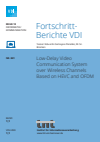Low-Delay Video Communication System over Wireless Channels Based on HEVC and OFDM
Zusammenfassung
This thesis provides an analysis of the entire video communication system assuming a wireless, frequency- and time-selective channel under low-delay constraints. The whole system consists of a standard-compliant video codec (HEVC), a channel codec and a modem (OFDM). A design methodology in terms of the rate-distortion optimization and a suitable framework to asses the entire system is proposed. It has synchronization capabilities and a suitable metric that turns out to be a key component of the rate-distortion based optimization procedure.
The trade-offs and interrelations of the parameters that have the most significant impact in the total distortion and robustness of the video signal are investigated. By means of intensive and sufficient simulations of an entire video transmission chain, it has been shown that the multiple techniques introduced and described in this thesis are viable tools for the design and optimization of specific video communication systems and its components.
C O N T E N T S
1 introduction 1
1.1 Basics of Video Communication Systems . . . . . . . . . . 1
1.2 Challenges . . . . . . . . . . . . . . . . . . . . . . . . . . . 3
1.2.1 Shannon’s Separati...
Schlagworte
- Kapitel Ausklappen | EinklappenSeiten
- 1–14 1 Introduction 1–14
- 120–124 5 Conclusions 120–124
- 125–138 Bibliography 125–138


